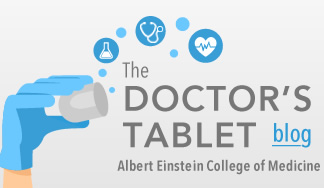FULL STORY
In Scientific First, Researchers Visualize Naturally Occurring mRNA
January 16, 2011 – (BRONX, NY) – In a technique that could eventually shed light on how gene expression influences human disease, scientists at Albert Einstein College of Medicine of Yeshiva University have for the first time ever successfully visualized single molecules of naturally occurring messenger RNA (mRNA) transcribed in living mammalian cells. The scientific achievement is detailed in the January 16 online edition of Nature Methods.

Robert Singer, Ph.D.Gene expression involves transcribing a gene's DNA into molecules of mRNA. These molecules then migrate from a cell's nucleus into the cytoplasm, where they serve as blueprints for protein construction.
Robert Singer, Ph.D., codirector of the Gruss Lipper Biophotonics Center and professor and cochair of anatomy and structural biology, was senior author of the paper. Working with his colleagues, he generated a transgenic mouse in which genes coding for the structural protein beta actin would, when expressed, yield fluorescently labeled mRNA. Beta actin mRNA is a highly expressed molecule found in all mammalian tissues.
The technique used by the Einstein researchers should be applicable for monitoring the expression of any gene of interest. Prior to this study, Einstein researchers had monitored mRNA molecules transcribed by artificial genes.
"Our report is the first demonstration that our technique can be used to visualize the expression of an essential gene in mammalian cells," said Timothée Lionnet, Ph.D., a research fellow in Dr. Singer's lab and lead author of the Nature Methods paper. "We can study beta actin RNA molecules over their life cycle in a variety of cell types and discover where they are distributed within the cell. This has important consequences for human disease like cancer, since the way molecules of mRNA are localized within tumor cells correlates with the ability of these cells to spread, or metastasize."
The study, "A transgenic mouse for in vivo detection of endogenous labeled mRNA," will be published in the January 16 online edition of Nature Methods. Other Einstein scientists involved in the study were Kevin Czaplinski, Amber Wells, Ph.D., Jeffrey Chao, Ph.D., Hye Yoon Park, Valeria de Turris and Melissa Lopez-Jones.
Other Top Stories
9/11 World Trade Center Exposure Linked to Heart Disease Among NYC Firefighters
On Becoming a Physician: New Einstein Students Receive White Coats and Stethoscopes
Novel Therapy for Acute Migraine Shows Promise in Phase 3 Clinical Trial
First Complete Wiring Diagram of an Animal's Nervous System
Multimillion Dollar NIH Grant to Help Reduce Opioid Use & Get Care to People Who Need It
NIH Grant Funds $23 Million Study of Diseases Affecting People Living with HIV
New TAILORx Data Guides Adjuvant Therapy in Younger Breast Cancer Patients
Einstein Celebrates Its 61st Commencement
Bolstering Biopsies: Testing Patients' Individual Cells to Guide Treatment



Tablet Blog